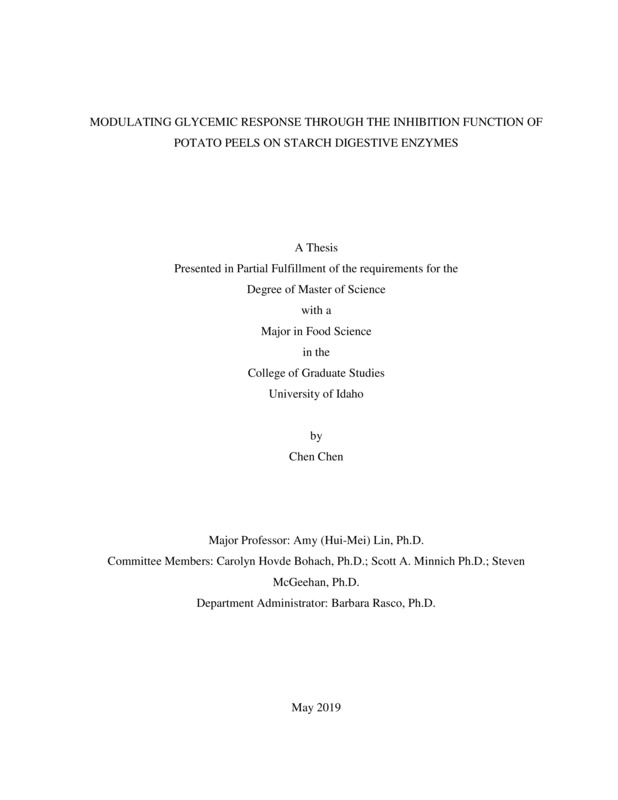Modulating glycemic response through the inhibition function of potato peels on starch digestive enzymes
Chen, Chen. (2019-05). Modulating glycemic response through the inhibition function of potato peels on starch digestive enzymes. Theses and Dissertations Collection, University of Idaho Library Digital Collections. https://www.lib.uidaho.edu/digital/etd/items/chen_idaho_0089n_11623.html
- Title:
- Modulating glycemic response through the inhibition function of potato peels on starch digestive enzymes
- Author:
- Chen, Chen
- Date:
- 2019-05
- Keywords:
- alpha-amylase glycemic response mucosal alpha-glucosidase Potato Peel Starch digestion
- Program:
- Food Science
- Subject Category:
- Food science
- Abstract:
-
Potato peel waste is a burden to the potato processing industry due to its large quantity and lack of utilization. On the other hand, obesity and type II diabetes, which correlated with the high glycemic response after starch ingestion, have become major health concerns worldwide. Potato peels, as an industrial waste, contain functional molecules (i.e., calystegine), which have the potential to modulate glycemic response through their inhibitory effect on starch degrading enzymes. In this research, the objectives were to investigate the inhibition of industrial potato peel waste on α-amylase and mucosal α-glucosidase, quantify and characterize inhibitors as well as study the effects of potato cultivars and peeling methods on inhibition performances. Potato peels were extracted with water, and an in vitro inhibition mechanism study of potato peel extract was conducted on α-amylase and mucosal α-glucosidase. A rat feeding study was performed to verify the impact of consuming potato peel extract on glycemic response. The concentrations of the potential inhibitors, including pectin, phenolic acids, minerals, and calystegine were quantified and correlated with measured inhibition on α-amylase and mucosal α-glucosidase. To evaluate the potential of utilizing the potato peels generated by potato processors, we examined five potato cultivars from two consecutive years, which are common cultivars used in processing in the United States Pacific Northwest. We also investigated the inhibition power of hand, steam, and abrasion peeling methods. The potato peel waste from two processors was included in this study to examine the potential of using real waste to modulate glycemic response. Our data showed that potato peel extract had a dose-response inhibition on both α-amylase and mucosal α-glucosidase in an in vitro system. The inhibition mechanism on α-amylase was noncompetitive inhibition while mixed inhibition mechanism was observed on mucosal α-glucosidase inhibition. In animal study, the consumption of potato peel extract delayed the presence of the glucose spike from 30 min to 60 min in a rat model. For inhibitor characterization and quantification, we identified four major types of phenolic acids in potato peel extract, and phenolic acid content were strongly correlated with both α-amylase (r = 0.62) and mucosal α-glucosidase (r = 0.50) inhibition. Our data also demonstrate that pectin had an inhibition on α-amylase at a dose of 5.6 mg/mL, however, the content of pectin in potato peel extract used in this study was not sufficient to generate a significant impact on α-amylase activity. For minerals, the total amount of copper, zinc and nickel, which were reported to have inhibition on both α-amylase and mucosal α-glucosidase, was in the range of 1.8 ug/mL to 20.2 ug/mL in the potato extract. Our results showed low correlation between mineral content and measured inhibition, which could result from the limited availability of ions due to the their interaction with other molecules in the peel extract. We identified five isoforms of calystegine in our potato peel extracts with the combined concentration of 4.2 ug/mL to 20.2 ug/mL. Statistical analysis showed high correlation (r = 0.65) between calystegine content and mucosal α-glucosidase inhibition, indicating calystegine is the major mucosal α-glucosidase inhibitor in the peel extract. When comparing cultivar differences and peeling methods, all of five potato cultivars had an inhibition power on starch degrading enzymes, and all the peeling methods preserved inhibition power over both enzymes as well. The growing environment had a significant impact on the inhibition power, which the potatoes grown in 2016 and 2017 had significant differences in their inhibition power (p = 0.003). Variations among the cultivars were observed, and Ranger Russet had the highest inhibition power among the five cultivars. Regarding the impact of peeling method on the inhibition performance, steam peeling method preserved the highest inhibition power among the three methods (p < 0.000). These findings support the hypothesis that potato peel wastes generated by the potato processors in the United States Pacific Northwest have a potential to modulate postpriandial glycemic response through their inhibition on starch digestive enzymes and thus, can be a valuable natural food ingredient that could help to treat obesity or type II diabetes symptoms.
- Description:
- masters, M.S., Food Science -- University of Idaho - College of Graduate Studies, 2019-05
- Major Professor:
- Lin, Hui-Mei
- Committee:
- Bohach, Carolyn; Minnich, Scott; McGeehan, Steven
- Defense Date:
- 2019-05
- Identifier:
- Chen_idaho_0089N_11623
- Type:
- Text
- Format Original:
- Format:
- application/pdf
- Rights:
- In Copyright - Educational Use Permitted. For more information, please contact University of Idaho Library Special Collections and Archives Department at libspec@uidaho.edu.
- Standardized Rights:
- http://rightsstatements.org/vocab/InC-EDU/1.0/

